Juniper
Junipers are coniferous trees and shrubs in the genus Juniperus /dʒuːˈnɪpərəs/[1] of the cypress family Cupressaceae. Depending on taxonomic viewpoint, between 50 and 67 species of junipers are widely distributed throughout the Northern Hemisphere, from the Arctic, south to tropical Africa, from Ziarat, Pakistan, east to eastern Tibet in the Old World, and in the mountains of Central America. The highest-known juniper forest occurs at an altitude of 16,000 ft (4,900 m) in southeastern Tibet and the northern Himalayas, creating one of the highest tree-lines on earth.[2]
| Juniper | |
|---|---|
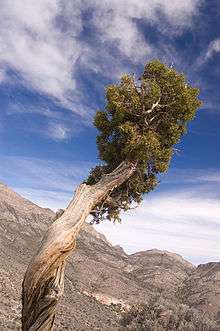 | |
| Juniperus osteosperma in Nevada, United States | |
| Scientific classification | |
| Kingdom: | Plantae |
| Clade: | Tracheophytes |
| Division: | Pinophyta |
| Class: | Pinopsida |
| Order: | Pinales |
| Family: | Cupressaceae |
| Subfamily: | Cupressoideae |
| Genus: | Juniperus L. |
Description
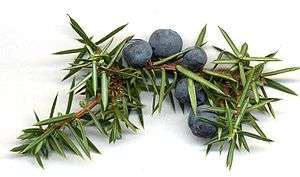
Junipers vary in size and shape from tall trees, 20–40 m (66–131 ft) tall, to columnar or low-spreading shrubs with long, trailing branches. They are evergreen with needle-like and/or scale-like leaves. They can be either monoecious or dioecious. The female seed cones are very distinctive, with fleshy, fruit-like coalescing scales which fuse together to form a "berry"-like structure, 4–27 mm (0.16–1.06 in) long, with one to 12 unwinged, hard-shelled seeds. In some species, these "berries" are red-brown or orange, but in most they are blue; they are often aromatic and can be used as a spice. The seed maturation time varies between species from 6 to 18 months after pollination. The male cones are similar to those of other Cupressaceae, with six to 20 scales.
In zones 7 through 10, junipers can bloom and release pollen several times each year. A few species of junipers bloom in autumn, while most species pollinate from early winter until late spring.[3]
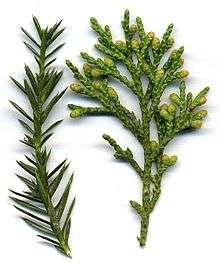
Many junipers (e.g. J. chinensis, J. virginiana) have two types of leaves; seedlings and some twigs of older trees have needle-like leaves 5–25 mm (0.20–0.98 in) long, and the leaves on mature plants are (mostly) tiny (2–4 mm (0.079–0.157 in)), overlapping, and scale-like. When juvenile foliage occurs on mature plants, it is most often found on shaded shoots, with adult foliage in full sunlight. Leaves on fast-growing 'whip' shoots are often intermediate between juvenile and adult.
In some species (e.g. J. communis, J. squamata), all the foliage is of the juvenile needle-like type, with no scale leaves. In some of these (e.g. J. communis), the needles are jointed at the base, while in others (e.g. J. squamata) the needles merge smoothly with the stem.
The needle-leaves of junipers are hard and sharp, making the juvenile foliage very prickly to handle. This can be a valuable identification feature in seedlings, as the otherwise very similar juvenile foliage of cypresses (Cupressus, Chamaecyparis) and other related genera is soft and not prickly.
Juniper is the exclusive food plant of the larvae of some moths and butterflies, including Bucculatrix inusitata, juniper carpet, Chionodes electella, Chionodes viduella, juniper pug, and pine beauty. Those of the tortrix moth Cydia duplicana feed on the bark around injuries or canker.
Junipers are gymnosperms, which means they have seeds, but no flowers or fruits. Depending on the species, the seeds they produce take 1–3 years to develop. The impermeable coat of the seed keeps water from getting in and protects the embryo when being dispersed. It can also result in a long dormancy that is usually broken by physically damaging the seed coat. Dispersal can occur from being swallowed whole by frugivores and mammals. The resistance of the seed coat allows it to be passed down through the digestive system and out without being destroyed along the way. These seeds last a long time, as they can be dispersed long distances over the course of a few years.[4]
Classification
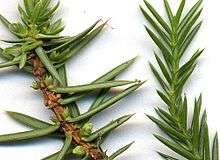
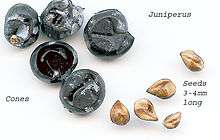
The number of juniper species is in dispute, with two studies giving very different totals: Farjon (2001) accepted 52 species and Adams (2004) accepted 67 species. The junipers are divided into several sections, though (particularly among the scale-leaved species) which species belong to which sections is still far from clear, with research still ongoing.
Juniperus sect. Juniperus – needle-leaf junipers; the adult leaves are needle-like, in whorls of three, and jointed at the base
- Juniperus sect. Juniperus subsect. Juniperus – cones with 3 separate seeds; needles with one stomatal band
- Juniperus communis – common juniper
- Juniperus communis subsp. alpina – alpine juniper
- Juniperus conferta – shore juniper
- Juniperus rigida – Temple juniper or needle juniper
- Juniperus communis – common juniper
- Juniperus sect. Juniperus subsect. Oxycedrus – cones with 3 separate seeds; needles with two stomatal bands
- Juniperus brevifolia – Azores juniper
- Juniperus cedrus – Canary Islands juniper
- Juniperus formosana – Chinese prickly juniper
- Juniperus lutchuensis – Ryukyu juniper
- Juniperus oxycedrus – Western prickly juniper, cade juniper
- Juniperus macrocarpa – large-berry juniper
- Juniperus sect. Juniperus subsect. Caryocedrus – cones with 3 seeds fused together; needles with two stomatal bands
- Juniperus drupacea – Syrian juniper
Juniperus sect. Sabina – scale-leaf junipers; adult leaves are mostly scale-like, similar to those of Cupressus species, in opposite pairs or whorls of three, and the juvenile needle-like leaves are not jointed at the base (including in the few that have only needle-like leaves; see below right). Provisionally, all the other junipers are included here, though they form a paraphyletic group.
- Old World species
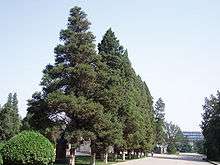
- Juniperus chinensis – Chinese juniper
- Juniperus convallium – Mekong juniper
- Juniperus excelsa – Greek juniper
- Juniperus excelsa polycarpos – Persian juniper
- Juniperus foetidissima – stinking juniper
- Juniperus indica – black juniper
- Juniperus komarovii – Komarov's juniper
- Juniperus phoenicea – Phoenicean juniper
- Juniperus pingii – Ping juniper
- Juniperus procera – East African juniper
- Juniperus procumbens – Ibuki juniper
- Juniperus pseudosabina – Xinjiang juniper
- Juniperus recurva – Himalayan juniper
- Juniperus sabina – Savin juniper
- Juniperus saltuaria – Sichuan juniper
- Juniperus semiglobosa – Russian juniper
- Juniperus squamata – flaky juniper
- Juniperus thurifera – Spanish juniper
- Juniperus tibetica – Tibetan juniper
- Juniperus wallichiana – Himalayan black juniper
New World species
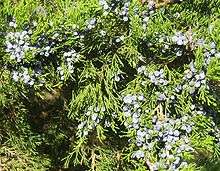
- Juniperus angosturana – Mexican one-seed juniper
- Juniperus ashei – Ashe juniper
- Juniperus arizonica – redberry juniper, roseberry juniper
- Juniperus barbadensis – West Indies juniper
- Juniperus bermudiana – Bermuda juniper
- Juniperus blancoi – Blanco's juniper
- Juniperus californica – California juniper
- Juniperus coahuilensis – Coahuila juniper
- Juniperus comitana – Comitán juniper
- Juniperus deppeana – alligator juniper
- Juniperus durangensis – Durango juniper
- Juniperus flaccida – Mexican weeping juniper
- Juniperus gamboana – Gamboa juniper
- Juniperus grandis – Sierra juniper
- Juniperus horizontalis – creeping juniper
- Juniperus jaliscana – Jalisco juniper
- Juniperus maritima – seaside juniper
- Juniperus monosperma – one-seed juniper
- Juniperus monticola – mountain juniper
- Juniperus occidentalis – western juniper
- Juniperus osteosperma – Utah juniper
- Juniperus pinchotii – Pinchot juniper
- Juniperus saltillensis – Saltillo juniper
- Juniperus scopulorum – Rocky Mountain juniper
- Juniperus standleyi – Standley's juniper
- Juniperus virginiana – eastern juniper, eastern redcedar
- Juniperus virginiana subsp. silicicola – Southern juniper
- Juniperus zanonii (proposed)[5]
Ecology
Juniper plants thrive in a variety of environments. The junipers from Lahaul valley can be found in dry, rocky locations planted in stony soils. These plants are being rapidly used up by grazing animals and the villagers. There are several important features of the leaves and wood of this plant that cause villagers to cut down these trees and make use of them.[6] Additionally, the western juniper plants, a particular species in the juniper genus, are found in woodlands where there are large, open spaces. Junipers are known to encompass open areas so that they have more exposure to rainfall.[4] Decreases in fires and a lack of livestock grazing are the two major causes of western juniper takeover. This invasion of junipers is driving changes in the environment. For instance, the ecosystem for other species previously living in the environment and farm animals has been compromised.[7] When junipers increase in population, there is a noticeable decrease in woody species like mountain big sagebrush and aspen. Among the juniper trees themselves, there is a lot of competition. The cost of this is a decrease in berry production.[8] Herbaceous cover decreases, and junipers are often mistaken for weeds. As a result, several farmers have thinned the juniper trees or removed them completely. However, this reduction did not result in any significant difference on wildlife survival. Some small mammals found it advantageous to have thinner juniper trees, while cutting down the entire tree was not favorable.[9][10]
Some junipers are susceptible to Gymnosporangium rust disease, and can be a serious problem for those people growing apple trees, an alternate host of the disease.
Cultivation and uses
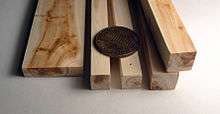

Timber
Some junipers are given the common name "cedar," including Juniperus virginiana, the "red cedar" that is used widely in cedar drawers and closets.[11] The lack of space or a hyphen between the words "red" and "cedar" is sometimes used to indicate that this species is not a true cedar, Cedrus.[12]
Juniper in weave is a traditional cladding technique used in Northern Europe, e.g. at Havrå, Norway.[13]
Culinary use
Juniper berries are a spice used in a wide variety of culinary dishes and best known for the primary flavoring in gin (and responsible for gin's name, which is a shortening of the Dutch word for juniper, jenever). A juniper based spirit is made by fermenting juniper berries and water to create a "wine" that is then distilled. This is often sold as a juniper brandy in eastern Europe. Juniper berries are also used as the primary flavor in the liquor Jenever and sahti-style of beers. Juniper berry sauce is often a popular flavoring choice for quail, pheasant, veal, rabbit, venison, and other game dishes.
Essential oil
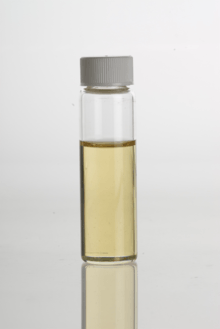
Juniper berries are steam distilled to produce an essential oil that may vary from colorless to yellow or pale green.[14] Some of its chemical components are terpenoids and aromatic compounds, such as cadinene, a sesquiterpene.[15]
Ethnic and herbal use
Most species of juniper are flexible and have a high compression strength-to-weight ratio.[16] This has made the wood a traditional choice for the construction of hunting bows among some of the Native American cultures in the Great Basin region.[17] These bow staves are typically backed with sinew to provide tension strength that the wood may lack.[16]
Some Indigenous peoples of the Americas use juniper in traditional medicine; for instance the Dineh, who use it for diabetes.[18] Juniper ash has also been historically consumed as a source of calcium by the Navajo people.[19][20]
Juniper is traditionally used in Scottish folkloric and Gaelic Polytheist saining rites, such as those performed at Hogmanay (New Year), where the smoke of burning juniper, accompanied by traditional prayers and other customary rites, is used to cleanse, bless, and protect the household and its inhabitants.[21]
Wood and leaves
Local people in Lahaul Valley present juniper leaves to their deities as a folk tradition. It is also useful as a folk remedy for pains and aches, as well as epilepsy and asthma. They are reported to collect large amounts of juniper leaves and wood for building and religious purposes.[6]
Ornamental use
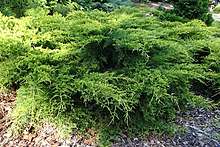
Junipers are among the most popular conifers to be cultivated as ornamental subjects for parks and gardens. They have been bred over many years to produce a wide range of forms, in terms of colour, shape and size. They include some of the dwarfest (miniature) cultivars. They are also used for bonsai. Some species found in cultivation include:
- J. chinensis
- J. communis
- J. horizontalis
- J. × pfitzeriana
- J. procumbens
- J. rigida
- J. scapulorum
- J. squamata
Allergenic potential
In drier areas, juniper pollen easily becomes airborne and can be inhaled into the lungs. This pollen can also irritate the skin and cause contact dermatitis. Cross-allergenic reactions are common between juniper pollen and the pollen of all species of cypress.[3]
Monoecious juniper plants are highly allergenic, with an OPALS allergy scale rating of 9 out of 10. Completely male juniper plants have an OPALS rating of 10, and release abundant amounts of pollen. Conversely, all-female juniper plants have an OPALS rating of 1, and are considered "allergy-fighting".[3]
References
- Sunset Western Garden Book, 1995:606–607
- Hampe, Hampe; Petit, Re´my J. (2010). "Cryptic forest refugia on the 'Roof of the World'". New Phytologist. 185 (1): 5–7. doi:10.1111/j.1469-8137.2009.03112.x. hdl:10261/64089. PMID 20088971.
- Ogren, Thomas (2015). The Allergy-Fighting Garden. Berkeley, CA: Ten Speed Press. pp. 131–133. ISBN 978-1-60774-491-7.
- Chamber, J.C.; Vander Wall, S.B.; Schupp, E.W. (1999). "Seed and seedling ecology of pinon and juniper species in the pygmy woodlands of western North America". The Botanical Review. 65 (1): 1–38. doi:10.1007/bf02856556.
- Adams, Robert. "Phytologia (April 2010) 92(1)" (PDF). Archived from the original (PDF) on 2011-07-21.
- Rawat, Yashwant S.; Everson, Colin S. (2012-10-01). "Ecological status and uses of juniper species in the cold desert environment of the Lahaul valley, North-western Himalaya, India". Journal of Mountain Science. 9 (5): 676–686. doi:10.1007/s11629-012-2274-0. ISSN 1672-6316.
- Belsky, A. Joy (1996). "Viewpoint: Western Juniper Expansion: Is It a Threat to Arid Northwestern Ecosystems?". Journal of Range Management. 49 (1): 53–59. doi:10.2307/4002725. JSTOR 4002725.
- Miller, Richard F.; Svejcar, Tony J.; Rose, Jeffrey A. (2000). "Impacts of Western Juniper on Plant Community Composition and Structure". Journal of Range Management. 53 (6): 574–585. doi:10.2307/4003150. JSTOR 4003150.
- Bombaci, Sara; Pejchar, Liba (2016). "Consequences of pinyon and juniper woodland reduction for wildlife in North America". Forest Ecology and Management. 365: 34–50. doi:10.1016/j.foreco.2016.01.018.
- Gallo, Travis; Stinson, Lani T.; Pejchar, Liba (2016). "Pinyon-juniper removal has long-term effects on mammals". Forest Ecology and Management. 377: 93–100. doi:10.1016/j.foreco.2016.06.029.
- "Eastern Red Cedar". MDC Discover Nature. Missouri Department of Conservation. Retrieved 15 July 2019.
- "Cedars - Trees of Reed". Retrieved 15 July 2019.
- Berge, Bjørn (2009). The Ecology of Building Materials (2nd ed.). Taylor & Francis. ISBN 978-1-85617-537-1.
- Cantrell, Charles L.; Zheljazkov, Valtcho D.; Carvalho, Camila R.; Astatkie, Tess; Jeliazkova, Ekaterina A.; Rosa, Luiz H. (9 September 2014). Chang, Ing-Feng (ed.). "Dual Extraction of Essential Oil and Podophyllotoxin from Creeping Juniper (Juniperus horizontalis)". PLoS ONE. 9 (9): e106057. doi:10.1371/journal.pone.0106057. ISSN 1932-6203. PMC 4159210. PMID 25203255.
- "Final report on the safety assessment of Juniperus communis extract, Juniperus oxycedrus extract, Juniperus oxycedrus tar, Juniperus phoenicea extract, and Juniperus virginiana extract". Int J Toxicol. 20 (Suppl 2): 41–56. 2001. doi:10.1080/10915810160233758. PMID 11558640.
- Hamm, Jim (March 2001). Traditional Bowyers Bible, Volume 2. Lyons Press. p. 117. ISBN 1585740861.
- Millar CI, Smith KT (2017). "Reconsidering the process for bow-stave removal from juniper trees in the Great Basin" (PDF). Journal of California and Great Basin Anthropology. 37 (2): 125–131.CS1 maint: uses authors parameter (link)
- McCabe, Melvina; Gohdes, Dorothy; Morgan, Frank; Eakin, Joanne; Sanders, Margaret; Schmitt, Cheryl (2005). "Herbal therapies and diabetes among Navajo Indians" (PDF). Diabetes Care. 28 (6): 1534–1535. doi:10.2337/diacare.28.6.1534-a. PMID 15920089.
- Christensen, Nedra K; Sorenson, ANN W; Hendricks, Deloy G; Munger, Ronald (1998). "Juniper Ash as a Source of Calcium in the Navajo Diet". Journal of the American Dietetic Association. 98 (3): 333–4. doi:10.1016/s0002-8223(98)00077-7. PMID 9508018.
- Ballew, Carol; White, Linda L.; Strauss, Karen F.; Benson, Lois J.; Mendlein, James M.; Mokdad, Ali H. (1997-10-01). "Intake of Nutrients and Food Sources of Nutrients among the Navajo: Findings from the Navajo Health and Nutrition Survey". The Journal of Nutrition. 127 (10): 2085S–2093S. doi:10.1093/jn/127.10.2085s. ISSN 0022-3166. PMID 9339174.
- McNeill, F. Marian (1961). "X Hogmany Rites and Superstitions". The Silver Bough, Vol.3: A Calendar of Scottish National Festivals, Halloween to Yule. Glasgow: William MacLellan. p. 113. ISBN 978-0-948474-04-0.
Further reading
- Adams, R. P. (2004). Junipers of the World: The genus Juniperus. Victoria: Trafford. ISBN 1-4120-4250-X
- Farjon, A. (2001). World Checklist and Bibliography of Conifers. Kew. ISBN 1-84246-025-0
- Farjon, A. (2005). Monograph of Cupressaceae and Sciadopitys. Royal Botanic Gardens, Kew. ISBN 1-84246-068-4
- Mao, K.; Hao, G.; Liu, J.; Adams, R. P.; Milne (2010). "Diversification and biogeography of Juniperus (Cupressaceae): variable diversification rates and multiple intercontinental dispersals". New Phytologist. 188 (1): 254–272. doi:10.1111/j.1469-8137.2010.03351.x. PMID 20561210.
External links
- Junipers of the world
- Gymnosperm Database – Juniperus
- Arboretum de Villardebelle Photos of cones and foliage of selected species
- . Encyclopædia Britannica (11th ed.). 1911.
- . Encyclopedia Americana. 1920.